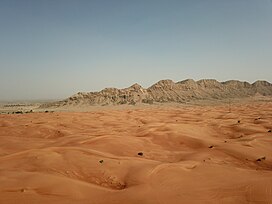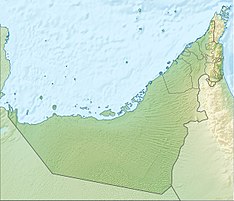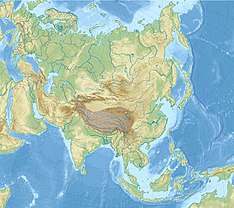Jebel Faya
| Jebel Faya | |
|---|---|
 Jebel Faya, as seen from the desert East of the range | |
| Highest point | |
| Elevation | 412 m (1,352 ft) |
| Coordinates | 25°07′08″N 55°50′49″E / 25.119°N 55.847°E[1] |
| Naming | |
| Language of name | Arabic |
| Geography | |
| Location | United Arab Emirates |
| Parent range | Al Hajar Mountains[2] |
Jebel Faya (Arabic: جَبَل ٱلْفَايَة, romanized: Jabal Al-Fāyah; FAY-NE1) is an archaeological site and limestone hill[3] or escarpment near Al Madam in the Emirate of Sharjah, the UAE, located about 50 km (31 miles) east of the city of Sharjah,[4] and between the shoreline of the Gulf and Al Hajar Mountains.[2] It contains tool assemblages from the Paleolithic, Neolithic, Bronze Age, and Iron Age reflecting human occupation of the region between 210,000 and 2,300 years ago.[1][5] Because its deep deposits contain an assemblage that has been dated to 125,000 years ago, the site was thought to contain the world's most ancient settlement yet discovered of anatomically modern humans outside of Africa at the time of its publication in 2011.[1] Finds of a yet earlier date (185,000 years) have since been found at Misliya cave in the Levant.[6][7][8]
The finds from excavations at Faya and surrounding digs are displayed at the Mleiha Archaeological Centre.
Site history
[edit]Excavations at Jebel Faya were first conducted between 2003 and 2010 by Simon J. Armitage, Sabah A. Jasim, Anthony E. Marks, Adrian G. Parker, Vitaly I. Usik, and Hans-Peter Uerpmann.[1] Knut Bretzke, Nicholas J. Conard, and Hans-Peter Uerpmann also reported on the FAY-NE1 sequence after conducting excavations between 2009 and 2013.[9] Additional excavations have studied the site's environmental and geologic context (see Bretzke et al. 2013, Parton et al. 2015, and Rosenberg et al. 2011). Although Jebel Faya's Paleolithic-aged context has been more intensively studied, in 2013 Hans-Peter Uerpmann, Margarethe Uerpmann, Adelina Kutterer, and Sabah A. Jasim published findings on the Neolithic period at the site.[10]
Findings
[edit]Site description
[edit]Jebel Faya is a limestone mountain outlier in the Central Region of the Emirate of Sharjah, measuring about 10 and 20 km (6.2 and 12.4 miles) long.[4][2] The archaeological site itself is called FAY-NE1, a rock shelter located at the northeastern endpoint of Jebel Faya.[1] Archaeologists have excavated several trenches at the site, with an area of over 150 meters2 excavated in total. It has a 5 m (16 ft) deep stratified sequence of archaeological levels, containing deposits from the Bronze and Iron Ages, the Neolithic, and the Paleolithic.[1][9]
Environmental context
[edit]
Paleolithic occupations at Jebel Faya have been linked to humid periods in southern Arabia, in which freshwater availability and vegetation cover of the area would have increased and supported human subsistence. In 2013, Bretzke et al. analyzed sediment columns from trenches at FAY-NE1. While Assemblages A, B, and C showed evidence of vegetation, the layers lacking archaeological deposits showed evidence of desiccation.[11] Additional studies of alluvial fan records[12] and relic lake deposits[13] in the region have supported this theory that humid periods may have offered multiple opportunities for human dispersal in southern Arabia.[14]
Deposits
[edit]The Paleolithic layers at FAY-NE1 were first described by Armitage et al. and were dated using single-grain optically stimulated luminescence (OSL). The horizons are as follows, from top to bottom:[1][9][15]
- Assemblage A
Dated to approximately 40,000 years ago. Recovered tools include burins, retouched pieces, end scrapers, sidescrapers, and denticulates.
- Assemblage B
Not yet dated. Recovered tools resemble those of Assemblage A.
- Assemblage C
Dated to approximately 125,000 years ago. Recovered tools include small hand axes, foliates, end scrapers and sidescrapers, and denticulates. Evidence of the Levallois production technique is unique to Assemblage C.[1]
Stone tools are thought to have been associated with Homo sapiens living in Africa at that time, and this shows that modern sapiens may have expanded Africa more quickly than thought.[15]
Paleolithic Assemblages D and E are also present, but have not been discussed in detail due to a small number of finds.[9]
Neolithic levels
[edit]The Neolithic levels at FAY-NE1 consist of approximately 1 meter of sediment. A layer of sand above Assemblage A seals the Neolithic context from the Paleolithic. This layer contains Faya arrowheads and shell fragments, dated to about 9500 years BP. Hans-Peter Uerpmann and his colleagues attribute these artifacts to the first reoccupation of the site since its last abandonment in the Paleolithic. The layers above this sand level are less distinct and have not provided significant information about late Neolithic occupation.[10]
Significance
[edit]Although no human fossils have been found at Jebel Faya, Armitage and others have argued that the Assemblage C artifacts, dated to 125,000 years BP, were produced by anatomically modern humans (AMH). This is because Assemblage C resembles contemporary east and northeast African technology more than the technology found at sites elsewhere on the Arabian peninsula.[1] As a result, the evidence at Jebel Faya has been used to support the idea of an early dispersal of AMH from the Horn of Africa across southern Arabia and into southern Asia.[16] According to this theory, modern humans dispersed out of Africa before the eruption of the Toba supervolcano 70–75,000 years BP. This claim is based on excavations at Jwalapuram in India by Petraglia et al., who argue that assemblages found in pre- and post-Toba eruption layers indicate the continuous presence of AMH.[17] For Petraglia and his colleagues, the presence of AMH at Jebel Faya 125,000 years ago could be evidence of an early dispersal route out of Africa, which humans could have followed to south Asia.[16] However, there is strong opposition to this notion, as critics have argued that the Assemblage C evidence is not enough to confirm the presence of AMH from Africa. According to Paul Mellars, who believes that significant modern human dispersals did not occur until after the Toba eruption, “There's not a scrap of evidence here that these were made by modern humans, nor that they came from Africa.”[18]
Studies about Jebel Faya's environmental context have indicated the potential for human dispersals out of Africa during humid periods in southern Arabia. These periods coincide with occupation at FAY-NE1, and depict activity at Jebel Faya as a cycle of occupation and abandonment according to the availability of water and vegetation.[11][12][13][14] However, although these studies demonstrate the site's attractiveness during humid periods, there is an ongoing debate about the identity of its occupants.[9]
Due to their dissimilarity from any other Middle or Late Stone Age assemblages, Assemblages B and A have been attributed to indigenous developments, which may indicate that Jebel Faya was inhabited continuously.[1] However, this conclusion has been questioned due to genetic evidence of a more rapid dispersal of AMH out of Africa, meaning the Paleolithic assemblages may be the products of unrelated populations.[16]
At the moment, however, it is considered possible.[19]
See also
[edit]References
[edit]- ^ a b c d e f g h i j Armitage, Simon; Sabah A. Jasim; Anthony E. Marks; Adrian G. Parker; Vitaly I. Usik; Hans-Peter Uerpmann (28 January 2011). "The Southern Route "Out of Africa": Evidence for an Early Expansion of Modern Humans into Arabia". Science. 331 (6016): 453–456. Bibcode:2011Sci...331..453A. doi:10.1126/science.1199113. PMID 21273486. S2CID 20296624.
- ^ a b c Leech, Nick (2015-05-28). "The long read: Out of Arabia, the story of early humanity". The National. Retrieved 2020-01-30.
- ^ O'Reilly, Mick (2011-01-29). "Humans migrated even earlier". Gulf News. Dubai. Retrieved 2020-01-30.
- ^ a b Archaeological sites: Rock shelter site at Jebel Faya, Art Destination Sharjah, retrieved 2020-01-30
- ^ Bretzke, Knut; F. Preusser; S.A. Jasim; C. Miller; G. Preston; K. Raith; S.J. Underdown; A. Parton; A.G. Parker (31 January 2022). "Multiple phases of human occupation in Southeast Arabia between 210,000 and 120,000 years ago". Scientific Reports. 12: 1600. doi:10.1038/s41598-022-05617-w. PMC 8803878.
- ^ "Scientists discover oldest known modern human fossil outside of Africa: Analysis of fossil suggests Homo sapiens left Africa at least 50,000 years earlier than previously thought". ScienceDaily. Retrieved 2018-01-28.
- ^ Ghosh, Pallab (2018). "Modern humans left Africa much earlier". BBC News. Retrieved 2018-01-28.
- ^ "Jawbone fossil found in Israeli cave resets clock for modern human evolution". Retrieved 2018-01-28.
- ^ a b c d e Bretzke, Knut; Conard, Nicholas John; Uerpmann, Hans-Peter (2014). "Excavations at Jebel Faya : The FAY-NE1 shelter sequence". Proceedings of the Seminar for Arabian Studies. Vol. 44. pp. 69–82. doi:10.15496/publikation-1356.
- ^ a b Uerpmann, Hans-Peter; Uerpmann, Margarethe; Kutterer, Adelina; Jasim, Sabah A. (2013-05-01). "The Neolithic period in the Central Region of the Emirate of Sharjah (UAE)". Arabian Archaeology and Epigraphy. 24 (1): 102–108. doi:10.1111/aae.12019. ISSN 1600-0471.
- ^ a b Bretzke, Knut; Armitage, Simon J.; Parker, Adrian G.; Walkington, Helen; Uerpmann, Hans-Peter (2013-06-25). "The environmental context of Paleolithic settlement at Jebel Faya, Emirate Sharjah, UAE". Quaternary International. The Middle Palaeolithic in the Desert. 300: 83–93. Bibcode:2013QuInt.300...83B. doi:10.1016/j.quaint.2013.01.028.
- ^ a b Parton, A.; Farrant, A. R.; Leng, M. J.; Telfer, M. W.; Groucutt, H. S.; Petraglia, M. D.; Parker, A. G. (2015). "Alluvial fan records from southeast Arabia reveal multiple windows for human dispersal" (PDF). Geology. 43 (4): 295–298. Bibcode:2015Geo....43..295P. doi:10.1130/g36401.1.
- ^ a b Rosenberg, T. M.; Preusser, F.; Fleitmann, D.; Schwalb, A.; Penkman, K.; Schmid, T. W.; Al-Shanti, M. A.; Kadi, K.; Matter, A. (2011). "Humid periods in southern Arabia: Windows of opportunity for modern human dispersal". Geology. 39 (12): 1115–1118. Bibcode:2011Geo....39.1115R. doi:10.1130/g32281.1. S2CID 129464252.
- ^ a b Groucutt, Huw S.; Petraglia, Michael D. (2012-05-01). "The prehistory of the Arabian peninsula: Deserts, dispersals, and demography". Evolutionary Anthropology: Issues, News, and Reviews. 21 (3): 113–125. doi:10.1002/evan.21308. ISSN 1520-6505. PMID 22718479. S2CID 13705573.
- ^ a b Roberts, Alice (2018). Evolution: The Human Story. Revised edition. ISBN 978-1465474018.
- ^ a b c Petraglia, Michael D. (2011). "Archaeology: Trailblazers across Arabia". Nature. 470 (7332): 50–51. Bibcode:2011Natur.470...50P. doi:10.1038/470050a. PMID 21293370.
- ^ Petraglia, Michael; Korisettar, Ravi; Boivin, Nicole; Clarkson, Christopher; Ditchfield, Peter; Jones, Sacha; Koshy, Jinu; Lahr, Marta Mirazón; Oppenheimer, Clive (2007-01-01). "Middle Paleolithic Assemblages from the Indian Subcontinent before and after the Toba Super-Eruption". Science. 317 (5834): 114–116. Bibcode:2007Sci...317..114P. doi:10.1126/science.1141564. JSTOR 20036656. PMID 17615356. S2CID 20380351.
- ^ Lawler, Andrew (2011-01-28). "Did Modern Humans Travel Out of Africa Via Arabia?". Science. 331 (6016): 387. Bibcode:2011Sci...331..387L. doi:10.1126/science.331.6016.387. ISSN 0036-8075. PMID 21273459.
- ^ "BT YTree".
External links
[edit]- Lost Civilization May Have Existed Beneath the Persian Gulf - December 10, 2010
- Nature: Early human migration written in stone tools - 27 January 2011
- Science: Did Modern Humans Travel Out of Africa Via Arabia? - 28 January 2011 (requires subscription or proxy)
- What's a prehistoric toolkit and how could it rewrite human history? – The Tools of Jebel Faya
- Jebel Faya (YouTube)
- Paragliding in U.A.E ( Jebel Faya Sharjah )
- Stone Axe 150.000 years from Jebel Faya Sharjah أداة حجرية من 150.000 سنة من جبل فاية الشارقة







